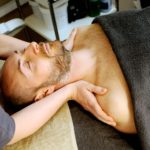Normally, I don’t write about massage therapy; however, as almost all massage therapists can attest to, there are still so many misconceptions about the industry and most of us have to listen to people talk about why they don’t like massages because… well, either they had a bad experience, “don’t like to be touched,” or are so misinformed about the purpose of massage therapy that they have never actually received a session. The last one makes me smile as I get to hear what their unfounded “reasons” are while they tell anyone who will listen. Then, there are those who had a certain expectation going into a session, which did not result, and so they question the pricing. Every therapist has heard, “You charge how much? Well, I can get a $20 massage in (insert foreign country here),” or “I can get a $20 massage down in (insert part of city here). To these people, I just smile and tell them to go wherever they are comfortable spending their money.
I Don’t Get It…
My first experience receiving a massage was awful. I was informed that I would be relaxed following the session. However, during the session, the therapist stuck her elbows into my muscles without warming up the tissue or taking into consideration that I had never received a massage prior to this occasion. This latter fact does actually come into play if you’ve never received a massage before. Needless to say, it was a long, painful hour and in the days following the session, I felt like I’d been in a car wreck. I didn’t understand what kind of person would actually pay to be “abused” in this way and how it could possibly be considered “relaxing.”
Based on my first experience, which I still remember vividly, I can understand why some people who might have had a similar experience say that they don’t like massages.
A couple of years later, a friend gifted a massage session to me. I graciously declined and told her about my prior experience. She informed me that my session had not been the norm and asked that I try again using her gift.
A Complete 180°…
My second session was the complete opposite of the first. The therapist checked to see how I was feeling, increasing the pressure (not depth, which is completely different) at my discretion, and I fell asleep on the table. After that session, I completely understood why people would get massages for relaxation and I went on with my life thinking that massage was a great luxury to receive from time to time and, maybe someday, I would put it in my budget to receive another one.
Don’t Tell Me What I Can and Can’t Do…
Fast forward 5 years. At that point, I had been involved in two auto accidents, one where I was hit from behind and the other where I was t-boned, and was told by the medical profession that my body was healed “as good as it was going to be.” Admittedly, I’m a bit stubborn, so I continued to participate in all of my favorite physical activities (weight lifting, running, aerobics, dancing, etc) despite what I was told and despite the pain and functional changes in my body from the accidents.
One day out of the blue, a massage therapist friend of mine suggested that I might like being a therapist, since I refused to stop doing what I loved and stayed involved in the fitness industry. She also knew I have a passion for anything related to anatomy, so that was her selling point, and after giving it a lot of thought, I felt I could help more people, so I finally gave in and attended massage school. Keep in mind, I still hadn’t had a third massage.
An Unexpected Discovery…
While at school, my eyes were opened to that fact that massage is not just for relaxation or a luxury. It “reminds” the muscles using their own muscle memory to restore bodies to homeostasis. This means that massage can be used to rid the body of aches and pains that bodies acquire over time, due to stress, function, injury, daily life routines, and more. And that’s exactly what it did for me. By the time I graduated, my body was, for all intents and purposes, back to its pre-accident state. I was stunned and amazed and wanted to share this with the world.
The Muscles Have Memories…
To get a bit in-depth, I’m going to explain something about massage therapy. Fitness professionals already know that no two bodies are alike and there are imbalances to overcome. However, being a therapist also allowed me to discover that while every body has the same anatomy, with a few exceptions, not one body has the same muscle memory.
Yes, each muscle functions roughly the same way in every body, but the tight muscles in your neck or shoulders or back are not exactly the same as someone else’s muscle tightness in the same areas.
For example, you may have injured a limb and your muscles remember this, thereby carrying that limb and responding to movement differently than someone who has never injured that limb. You may have been an athlete or been in an accident which cause your muscles to function differently than someone who has never experienced either.
In fitness, I can help with imbalances and body issues, including fat loss, muscle toning/building, and nutrition, by focusing on functional movement and how the body systems work together. As a massage therapist, I can also help address imbalances by using manual manipulation to reduce functional issues (even during a fitness session) in order to achieve health and fitness goals. The bonus with massage therapy is that it also includes natural stress relief for the receiver.
Different Strokes For Different Folks…
Now, going back to my opening statements… as a therapist, I’ve discovered that the people who say that they don’t get massages because they hurt or don’t like to be touched are usually the ones that need massages the most. They have just been the unfortunate bodies who have received types of massage that their bodies haven’t needed at the time that they received it. There’s also a misconception of who needs a “deep tissue” session and what exactly that means, which has lead to the belief that massages have to hurt or a person has to live with pain for one to several days after a massage in order to reap its benefits. Neither of these are true.
It’s my belief that those who say that they’ve never had a massage and have all the excuses not to get one, are afraid. Getting a massage is personal, yes, because the recipient is the only one that can feel things like pressure, relaxation, etc. It can also be received while fully clothed and it’s fairly safe to say that the result won’t be death, so there’s really nothing to be afraid of. Therefore, my response to those people is, “then don’t get a massage.” If asked, I will inform, but it’s not my mission to convince someone to try something they are afraid to do.
I will address the following one time: For those who think there is anything remotely sexual about receiving a massage therapy session, I ask that they please go back to whatever rock they crawled out from under.
If you are going to receive a massage therapy session, here are a few tips:
- There is a difference between firm pressure and deep tissue work.
- Not everyone needs a deep tissue massage.
- Deep tissue is basically a relaxing massage on the deeper layers of the body. Yes, it is possible to fall asleep while receiving deep tissue work.
- Deep tissue and feeling the “knots” being worked on are not the same thing.
- Deep tissue and trigger point therapy are not the same thing.
When you go to a session:
- Let the therapist know what your experience with massages has been (or whether you’ve had a massage before) and that you would like to relax during the session. Trust me on this. The therapist can work out “knots” while relaxing you.
- Let the therapist know where you feel you hold tension and, most importantly, to avoid the use of his/her elbows, at least in the first session. This tip is just in case you get a therapist who doesn’t yet know how to warm up the superficial tissue prior to moving into the deeper layers. There is nothing that wrecks a massage faster than getting an elbow into tissue that isn’t warmed up.
- Let the therapist know at any time during the session whether you would like more or less pressure on whatever area is being worked.
- Let the therapist know if you would like him/her to stay in a certain area to address an issue that you’ve been having. Not all sessions need to include the full body.
You May Like It Or You May Not And That’s Okay…
If you receive a session as you request, you may discover that you like the benefits of massage, both physically and psychologically. If, however, you are still convinced that you do not like receiving massages, then I recommend finding other ways to relax, de-stress, and relieve muscle tension. These might include taking a few minutes of quiet time while focusing on your breathing or finding ways to incorporate stretching into your daily routine.
If I had gone with my first impression, I would not only never have received a second massage, but I also would never have become a therapist and I feel that both would have been unfortunate.
If you’d like more information about what to ask for in a massage session, types of massage, or how massage can help with your health and fitness goals, please feel free to email or text me. Also, feel free to leave comments about your experiences below.
TTFN,
Jamie
Want to know what you can do? Show up and you’ll find out.





Leave a Reply